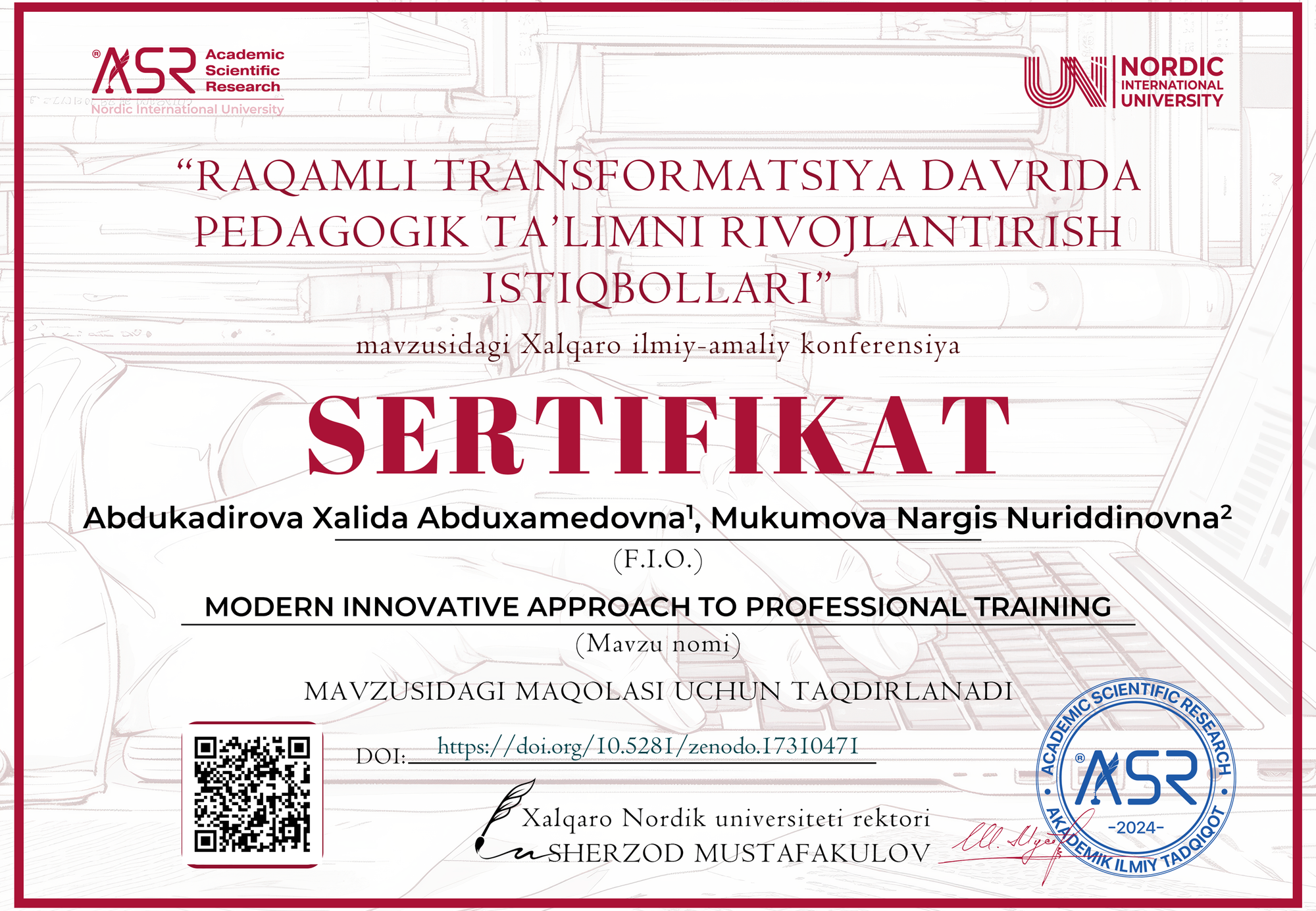Abdukadirova Xalida Abduxamedovna1, Mukumova Nargis Nuriddinovna2

DOI: https://doi.org/10.5281/zenodo.17310471
Google scholar:
Zenodo community: https://zenodo.org/records/17310471
Nordic_press journal: https://research.nordicuniversity.org/index.php/nordic/issue/view/14
MAQOLANI YUKLAB OLISH
SERTIFIKATNI YUKLAB OLISH
REVIEW:
1. General Overview
The article provides a well-structured and insightful examination of the role of innovation in professional training and human resource development within the framework of modern socio-economic transformations. The authors emphasize that the most sustainable nations in the world are those that rely on knowledge-based economies and innovative human capital, rather than physical or natural resources. The work successfully integrates both theoretical reflections and practical recommendations relevant to Uzbekistan’s current innovation-driven reforms.
2. Relevance and Contribution
The study is highly relevant to the ongoing transformation of education and personnel management in Uzbekistan and beyond. By focusing on digitalization, AI integration, and competency-based education, the authors contribute significantly to the discourse on how human capital becomes a strategic driver of competitiveness in modern economies.
Moreover, the article aligns well with Uzbekistan’s Action Strategy for 2017–2021, linking state policy with the development of an innovative workforce. This connection strengthens the paper’s practical importance.3. Structure and Clarity
The article is logically organized into distinct sections — Abstract, Introduction, Main Part, and Conclusion — allowing for a clear understanding of its argument. The introduction successfully contextualizes the topic within global and national priorities. The main section provides a detailed description of personnel innovations and discusses mechanisms such as reforming remuneration systems, financing science, and encouraging venture capital, which are crucial for sustainable innovation.
However, the inclusion of “Diagram 1” is mentioned but not visually presented in the text. For completeness and clarity, the authors could include the actual figure to better illustrate the data related to innovation trends.
4. Theoretical and Practical Value
The authors convincingly argue that human capital is the cornerstone of innovative development. They define personnel innovation not merely as technological improvement but as an ongoing process of creative problem-solving, professional motivation, and adaptation to digital transformation.
A valuable aspect of the paper is the discussion of contradictions within HR management, such as:
mismatches between production demands and workforce skills,
educational limitations in meeting qualification requirements,
disparities between elite and general personnel groups.
Highlighting these contradictions demonstrates the authors’ analytical depth and understanding of real-world challenges in human resource management.
5. Methodological Approach
While the article presents a solid conceptual and descriptive analysis, it would benefit from a more explicit methodological framework. The inclusion of empirical data, case studies, or comparative analysis with other countries could strengthen the research’s academic rigor and applicability.
6. Language and Style
The paper is written in clear, formal English with appropriate academic terminology. Key concepts such as innovative economy, talent management, and corporate culture are well-integrated. Occasionally, the text could be improved through slight stylistic refinement to enhance readability, particularly in long sentences. Nonetheless, the overall presentation is professional and coherent.
7. Conclusion and Evaluation
The article successfully demonstrates that innovative professional training and modern HR management are indispensable for building an effective and competitive economy. The authors underline that education and lifelong learning are the foundation of a nation’s progress.
By connecting innovation policy, human development, and economic modernization, the work contributes both theoretically and practically to the field of human capital management. It provides valuable insights for educators, policymakers, and researchers interested in innovation-driven education reform.
8. Final Assessment
Evaluation Criteria Rating (out of 5) Relevance of topic ⭐⭐⭐⭐⭐ Scientific depth ⭐⭐⭐⭐ Structure and clarity ⭐⭐⭐⭐ Practical significance ⭐⭐⭐⭐⭐ Originality ⭐⭐⭐⭐ Overall Rating: 4.5 / 5



